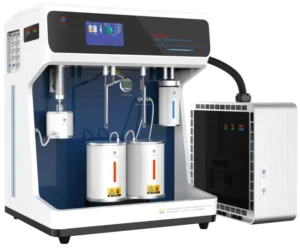Home / Blog / Temperature Programmed Reaction: Principles and Characteristics
Temperature Programmed Reaction: Principles and Characteristics
11 10 月, 2025From: BSD Instrument


1. Introduction
2. Principle of TPR
Key Steps in TPR:
Sample Preparation: The material (e.g., a catalyst or metal oxide) is placed in a reaction chamber. Gas Flow: A reactive gas (e.g., H₂ for reduction) is introduced along with an inert carrier gas (e.g., Ar or N₂). Temperature Ramp: The sample is heated linearly over time (e.g., 1–20 °C/min). Reaction Monitoring: As the temperature increases, the sample undergoes chemical reactions (e.g., reduction, oxidation, or desorption), releasing or consuming gases. Signal Detection: The consumption (or evolution) of reactive species (e.g., H₂ uptake in TPR) is measured, producing a TPR profile (temperature vs. signal intensity).
Example: TPR for Metal Oxides
When a metal oxide (e.g., CuO or NiO) is reduced by H₂, the reaction occurs at specific temperatures, producing H₂O. The peak positions in the TPR curve indicate the reduction temperatures of different metal species. The peak areas correlate with the amount of reducible species.
3. Characteristics of TPR
(a) Dynamic and Continuous Process
Unlike isothermal methods (constant temperature), TPR is a continuous, temperature-dependent technique, allowing the study of reactions over a wide thermal range.
(b) High Sensitivity to Surface Reactions
TPR is particularly useful for studying surface-active sites (e.g., catalytic metals, oxides, and supports). It can distinguish between different types of active sites based on their reduction/oxidation temperatures.
(c) Quantitative and Qualitative Insights
Qualitative: Identifies reaction phases and transition temperatures. Quantitative: Measures the amount of reactive species (e.g., H₂ consumption in TPR) and active site density.
(d) Non-Destructive (in most cases)
The sample remains largely intact after TPR, allowing further characterization (e.g., XRD, BET, or SEM).
4. Applications of TPR
Catalysis: Studying the reducibility of metal oxides (e.g., Pt, Ni, Fe-based catalysts). Surface Science: Investigating adsorption-desorption phenomena (TPD). Material Characterization: Determining oxidation states and active sites. Environmental Science: Analyzing soot oxidation (TPO) or pollutant decomposition.
5. Advantages and Limitations
Advantages:
Limitations:
6. Conclusion
Our Latest Blog & Articles
Stay updated with our latest news. Discover new product launches, innovative technologies, and upcoming events. Join our community and stay informed about all things lab equipment.
-
27 10 月, 2025
Cheap and Efficient Adsorption-Desorption Systems for Water Pollution Control in China
-
25 10 月, 2025
Gas Adsorption Analyzer Technologies: Advancements and Future Trends
-
23 10 月, 2025
Micropore and Mesopore Analysis for Improving Gas Storage and Separation Efficiency
-
20 10 月, 2025
Membrane Porosity and Its Impact on Mass Transport and Permeation Efficiency





